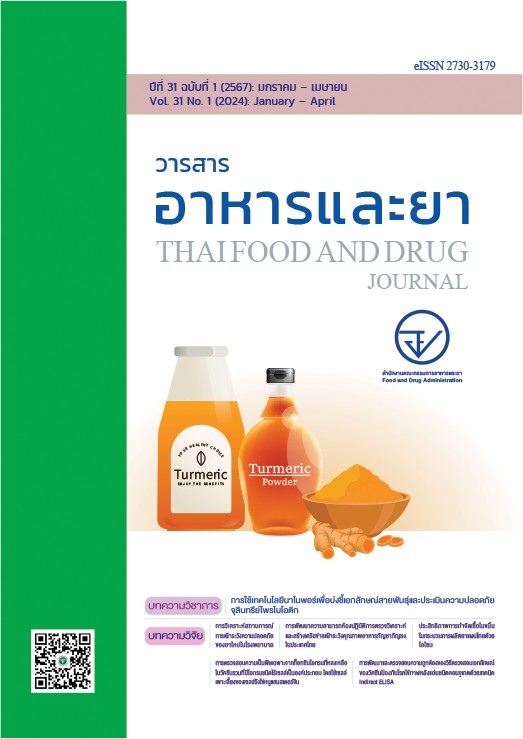การตรวจสอบความเป็นพิษเฉพาะจากท็อกซินไอกรนที่หลงเหลือในวัคซีนรวมที่มีไอกรนชนิดไร้เซลล์เป็นองค์ประกอบ โดยใช้เซลล์เพาะเลี้ยงของเซลส์รังไข่หนูแฮมสเตอร์จีน
Main Article Content
บทคัดย่อ
ความสำคัญ: โรคไอกรนสามารถป้องกันด้วยวัคซีนรวมที่มีไอกรนชนิดไร้เซลล์ (Acellular pertussis: aP) ที่มี Pertussis toxoid (PTd) และ Filamentous Haemagglutnin (FHA) เป็นองค์ประกอบหลัก ซึ่ง PTd คือท็อกซอยด์ที่ได้มาจากการทำให้ Pertussis toxin (PT) หมดความเป็นพิษลง เพื่อให้มั่นใจในความปลอดภัยของวัคซีน จึงต้องควบคุมระดับความเป็นพิษจาก PT ที่อาจหลงเหลืออยู่ในวัคซีนให้ตามข้อกำหนดมาตรฐาน โดยการทดสอบ Specific toxicity ที่ใช้หนูถีบจักรเป็นสัตว์ทดลอง (In vivo) แต่ก่อให้เกิดความทรมานต่อสัตว์ทดลอง ดังนั้นวิธีทางเลือก Chinese Hamster Ovary (CHO) cell assay จึงได้ถูกพัฒนาขึ้นเพื่อทดแทนการใช้สัตว์ทดลองตามหลักการ 3R โดยเซลล์ CHO-K1 มีความจำเพาะต่อ PT หากพบ PT หลงเหลืออยู่ ส่งผลทำให้เซลล์ CHO–K1 เกิดการเปลี่ยนแปลงรูปร่างเกาะกลุ่มคล้ายรูปดอกกุหลาบ
วัตถุประสงค์: เพื่อพัฒนาวิธีการตรวจสอบความเป็นพิษจากท็อกซินไอกรนในวัคซีนรวมสำเร็จรูปที่มีไอกรนชนิดไร้เป็นองค์ประกอบโดยใช้วิธีทางเลือก CHO cell assay สำหรับใช้ตรวจติดตามท็อกซินไอกรนที่อาจหลงเหลืออยู่ในผลิตภัณฑ์วัคซีน
วิธีการวิจัย: ศึกษาความถูกต้องของวิธีวิเคราะห์ความเป็นพิษเฉพาะจากท็อกซินไอกรนที่หลงเหลือในวัคซีนรวมที่มีไอกรนชนิดไร้เซลล์เป็นองค์ประกอบ โดยใช้เซลล์เพาะเลี้ยง CHO cells ซึ่งเป็นวิธีตรวจสอบในเชิงคุณภาพจึงดำเนินการศึกษาความถูกต้องของวิธีใน 2 พารามิเตอร์ คือ การตรวจสอบความจำเพาะของวิธี และขีดจำกัดของการตรวจพบ โดยอ้างอิงตามข้อกำหนดสากล ICH guideline เพื่อศึกษาสภาวะที่เหมาะสมและความถูกต้องของวิธี และดำเนินการทดสอบความเป็นพิษเฉพาะจากท็อกซินไอกรนที่หลงเหลือในวัคซีนรวม Tetanus toxoid, reduced diphtheria toxoid, acellular pertussis vaccine (Tdap) จำนวน 1 ตัวอย่าง
ผลการศึกษา: ผลการตรวจสอบความถูกต้องของวิธีด้วยสารมาตรฐานท็อกซินไอกรน (JNIH-5, NIBSC) พบว่าวิธีมีความจำเพาะต่อท็อกซินไอกรน พบการเกาะกลุ่มของเซลล์เป็นรูปดอกกุหลาบอย่างชัดเจน จึงเป็นวิธีที่มีความจำเพาะ และขีดจำกัดของปริมาณ PT ต่ำสุดที่สามารถตรวจพบจากการอ่านผลการทดสอบ มีค่าเท่ากับ 0.0015 IU/mL และเมื่อนำวิธีมาใช้ทดสอบกับวัคซีนป้องกันโรคคอตีบ บาดทะยัก และไอกรนชนิดไร้เซลล์ จำนวน 1 ตัวอย่างที่กำจัดสารเสริมฤทธิ์ออก พบว่าตัวอย่างให้ผลเป็นลบ แสดงว่าวัคซีนตัวอย่างไม่มีท็อกซินไอกรนหลงเหลือ
สรุป: วิธีการตรวจวิเคราะห์ความเป็นพิษเฉพาะจากท็อกซินไอกรนที่หลงเหลือในวัคซีนรวมที่มีไอกรนชนิดไร้เซลล์เป็นองค์ประกอบ โดยใช้เซลล์เพาะเลี้ยง CHO cell มีความจำเพาะเหมาะสมสามารถนำมาใช้เป็นวิธีมาตรฐานในการดำเนินการตรวจวิเคราะห์ความเป็นพิษเฉพาะจากท็อกซินไอกรนที่หลงเหลือในวัคซีนรวมที่มีไอกรนชนิดไร้เซลล์ทั้งผลิตภัณฑ์วัคซีนภายในประเทศและนำเข้ามาจากต่างประเทศได้
Article Details

อนุญาตภายใต้เงื่อนไข Creative Commons Attribution 4.0 International License.
เอกสารอ้างอิง
กองโรคป้องกันด้วยวัคซีน กรมควบคุมโรค กระทรวงสาธารณสุข. ตำราวัคซีนและการสร้างเสริมภูมิคุ้มกันโรค ปี 2562. กรุงเทพฯ: เวิร์ค พริ้นติ้ง จำกัด; 2562.
Lilley E, Isbrucker R, Ragan I, Holmes A. Integrating 3Rs approaches in WHO guidelines for the batch release testing of biologicals. Biologicals 2021;(74): 24-7.
World Health Organization. Chapter IV. 2.2.1 Chinese Hamster Ovary (CHO) cells assay for pertussis toxin. In: Manual for Quality Control of Diphtheria, Tetanus and Pertussis Vaccines. Geneva; 2013. p. 192-7.
ICH Harmonised Tripartite Guideline. Validation of Analytical Procedures: Text and Methodology Q2 (R1). International conference on harmonisation of technical requirements for registration of pharmaceuticals for human use [Internet]. 2005. [cited 2020 Dec 18]:1-17. Available from: https://www.gmp-compliance.org/files/guidemgr/Q2(R1).pdf
Isbrucker R, Daas A, Wagner L, Costanzo, A. Transferability study of CHO cell clustering assays for monitoring pertussis toxin activity in acellular pertussis vaccine. Pharmeur Bio Sci Notes 2016; :97-114.
Wagner LD, Corvette LJ, Ngundi MM, Burns DL. Towards replacement of the acellular pertussis vaccine safety test: Comparison of in vitro cytotoxic activity and in vivo activity in mice. Vaccine 2017; (35): 7160-5.


